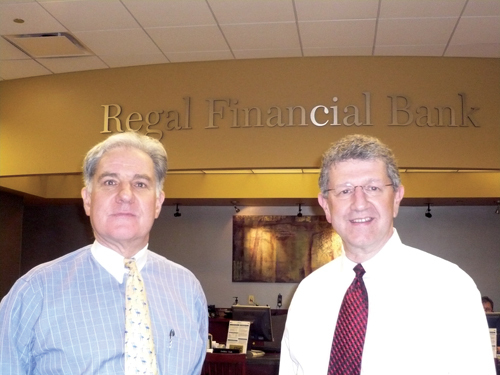Part 1 of 2: An exclusive with Regal Bank

William Glassford (left) and Douglas Kemper worked together 30 years ago at Rainier Bank. Now the two are teaming up once more to help Regal Financial Bank climb out of its economic woes. (Photo by Assunta Ng/NWAW)
By Assunta Ng
Northwest Asian Weekly
The results of the global banking crisis have trickled its way down to local Asian American banks, which have previously been successful. They currently suffer from a tough economic climate and involvement in risky real estate loans.
Ironically, Asian Americans were considered to be the pioneers of the banking industry among people of color.
Asian Americans started Washington state’s first bank in the 1960s. There are currently close to 10 Asian banks including local, national, and international offices. The Black community still does not have its own bank, and the Latino community founded its Plaza Bank in 2006.
In 2009, the Federal Deposit Insurance Corporation (FDIC) released the names of a number of banks (currently 28 in Washington), stating that they use “unsafe and unsound banking practices.” It requires these financial institutions to implement management reorganization and raise more capital within a time frame. Two of these banks, Regal Financial Bank and Washington First International Bank, have a strong focus on the local Asian community.
The Asian Weekly interviewed Regal’s new management team on Jan. 12 to see what its bank has done in compliance with the FDIC.
Regal’s challenges
Several challenges confront Regal. Two lawsuits were filed by Indonesians against the bank, its board, and its former chief executive and founder, Jesse Tam, on an alleged multi-million dollar Ponzi scheme. The suit in Utah was settled. The suit in Washington was dismissed, is on appeal, and a similar suit has been submitted. Tam, who is still a shareholder, left the bank in November.
On top of its credibility issue, Regal Financial is one of 25 Washington banks operating under a cease-and-desist order from federal and state regulators, forcing it to adopt a revival plan, according to an FDIC website.
Founded in 2002, Regal has $150 million in assets. It carries $16 million in bad real estate loans (though secured) and lost $7 million last year.
Regal wrote off $4 million. According to FDIC guidelines, Regal must raise $5 million within the next four months to prove its sustainability. Also, the bank must back up its plan with a new management team.
New management
Timing is everything. In April 2009, two veteran bankers who had just retired were looking for opportunities to start a bank from scratch.
William Glassford, 61, and Douglas Kemper, 62, had been good friends since they were colleagues at Rainier Bank 30 years ago. The two studied about 20 small banks, including Regal, and compared their strengths and weaknesses. They liked what they saw at Regal regarding its human resources, clientele, system, infrastructure, and board. They said they’d like to continue Regal’s mission of targeting the Asian American niche.
Glassford’s wife is Chinese American. Kemper has been a supporter of Asian American causes.
For Regal’s board — two of its seven members are Asian — the feeling was mutual, and it voted them in as part of the executive management. If banking regulators approve — the process typically takes 30 days — Glassford will be Regal’s chief executive officer (CEO) and Kemper will be its chief operating officer. The two are charged with putting the bank on a recovery course. Chuck Foisie is the interim CEO.
Vision and strategies
“[Regal is] a western bank that understands the Asian market,” said Kemper. “It is a specialty bank. It’s doing a few things very well. This will help to drive deposits and assets.”
“The Asian market is a proven fluent market on the West Coast,” said Glassford, “with liquidity.”
Why are these two getting into an already-competitive market? HSBC, a global bank with three local offices and a plan to add more, is interested in the same niche.
Glassford said Regal will be less complicated than a big bank. The Asian market is not as competitive as the mainstream market, Glassford said.
They plan to be active in the community. “We want to tell Regal’s story well and raise capital,” said Glassford.
Their focus will be SBA loans, community and business operation loans, mid-sized to small businesses, and green and clean industries. “It’s diversification and risk management to drive the bottom-line,” said Kemper. Real estate loans will not be one of its focuses due to the risks.
“We don’t need to do it fast,” Glassford said. “We just need to do it well.” The two said they want to establish a legacy and then transfer it to the next generation of management.
Current progress
So far, Regal has raised $1 million of the required $5 million. Ideally, Glassford said Regal would like to raise $15 million so that the bank can have more flexibility and build confidence for depositors.
The new team watches expenses carefully and has eliminated two branches, one in Las Vegas and the other in Boise. Its Bellevue office is under review. Presently, there are branches in downtown Seattle and Kent.
Flexibility is also a key. Glassford does not rule out the possibility of moving into the Chinatown/International District when its downtown lease is up in three years.
As for the lawsuit, Glassford said, “The bank has suffered reputation issues from a large lawsuit brought by an association that purports to represent a group of Indonesian investors, who, to the best of the bank’s knowledge, neither invested in nor have or ever had any banking relationship with Regal. The first lawsuit was dismissed and is on appeal. Regal intends to defend this lawsuit vigorously.”
So far, Regal’s cost in the lawsuit is in attorneys’ fee, and it is covered by the bank’s insurance, according to Glassford. ♦
Next week: Read the second part of this two-part series.
Assunta Ng can be reached at info@nwasianweekly.com.



